David Oistrakh Festival a Jewel on the Baltic
Mary Ellyn Hutton
Posted: Feb 21, 2008 - 3:49:39 PM in
news_2006
Note: The 2008 David Oistrakh Festival celebrating the centenary of the birth of the legendary violinist, takes place July 17-Aug. 1 in Pärnu, Estonia, complete schedule to be announced. For information, visit www.oistfest.ee.
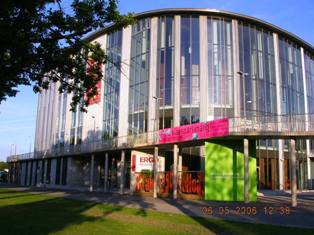
Pärnu Concert Hall, Pärnu, Estonia (photos by Mary Ellyn Hutton)
|
The three-week David Oistrakh Festival in Pärnu, Estonia is like a
jewel tucked away in a drawer. In this small town on the Baltic Sea, a
90-minute drive from Tallinn, one can experience a wide range of fine music in some of the loveliest and most congenial venues imaginable.
Russian violinist David Oistrakh, for whom the festival is named, spent
his summers here. Oistrakh’s wood-frame cottage, once filled with the
sound of
chamber music, is just around the corner from Tervis Spa, one of a
network of internationally known health spas located in Pärnu.
Imagine: You are walking down a narrow, tree-lined street. Sea gulls
and barn swallows fly overhead. On your left is the Pärnu River where
it empties into the Baltic, shops, cafes and baroque, red-spired Elizabeth Church on
your right. Pärnu’s brand new Kontserdimaja (Concert Hall) sparkles in
the sunlight as you turn onto Lai St. where the City Center Bridge leads across the river.
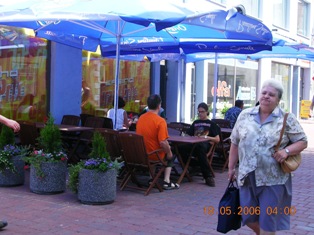
outdoor cafe in Pärnu, Estonia
|
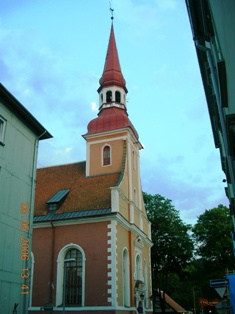
Elisabeth Lutheran Church in Pärnu, Estonia
|
Ushers in straw hats take your ticket 100 Estonian kroons (about $8)
is the top price and you head upstairs to the concert hall, a light,
bright space with a
single gallery encircling the main floor. Acoustics are fine-tuned and
warm, and the intimacy of the room (896 seats) draws you into the
performance.
At intermission, you enjoy a glass of wine and stroll onto a balcony
facing the river. The sun is beginning to dip toward the horizon
(sunset in July is 10-11 p.m.). At the concert’s end, ushers present arms full of flowers
including blue cornflowers, Estonia’s national flower to the
performers. It is a short walk
afterwards to one of the town’s many restaurants and cafes for a late evening dinner as the sun finally sets.
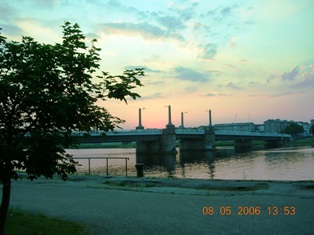
Pärnu River at sunset, July, 2006 (circa 11 p.m.)
|
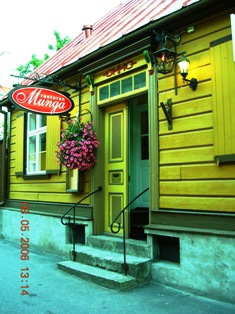
Munga Restaurant in Pärnu . Estonia
|
The 2006 Oistrakh Festival boasted 21 concerts July 2-22, featuring,
among others: the St. Petersburg Festival Chamber Orchestra led by
Neeme Järvi, Estonian National Orchestra led by Paavo Järvi, Kroumata Percussion
Ensemble of Sweden, violist Kim Kashkashian and pianist Lydia Artymiw,
Norway’s Trio Medieval, Estonia’s early music ensemble Hortus Musicus, cellist
Ramon Jaffe, Israel’s Aviv Quartet, pianist Antti Siirala, oboist Kalev
Kuljus, flutist Sharon Bezaly, harpist Katherine Gima, viola da gamba virtuoso Holger
Faust-Peters and harpsichordist Iren Lill, Renaissance lutenist
Hopkinson Smith, the RTE Vanbrugh Quartet of Ireland, soprano Patricia Rozario,
bass-baritone Lionel Lhote and an opera gala with rising young singers
from Moscow.
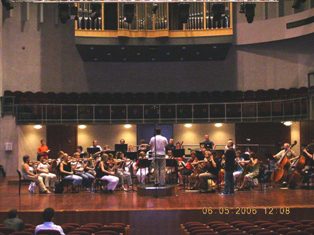
Paavo Järvi coaching Arndt Heyer in a master class onstage at Pärnu Concert Hall
|
A highlight of the annual event is the week-long Neeme Järvi Summer
Academy, a master course for young conductors held concurrently with
the festival since 2000. Student-led concerts are popular with audiences, who enjoy
hearing the newest young talent (15 students this year) and mixing with Järvi, a national hero whose return to his native country is always warmly welcomed. This year Paavo Jarvi, whose growing fame is likewise
shedding luster on Estonia, shared teaching honors with his father.
Music in Pärnu is virtually an equal match of performers, venues and
creature comforts even the natural world. *
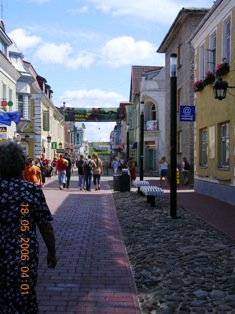
Rüütli Street, Pärnu, Estonia
|
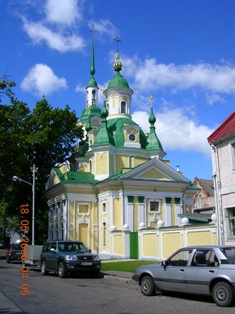
Catherine Orthodox Church, Pärnu, Estonia
|
The sea is warm, shallow and
inviting along Pärnu’s famous white sand beach. The parks are green and cool, and I
have never seen a pink-and-gold sunrise like the one I experienced on
the drive back to Tallinn for my return flight to the U.S.
I attended 14 of the 21concerts (some conflicted with master course
sessions). All were excellent. Some, like Kroumata, Hortus Musicus,
Trio Medieval and the St. Petersburg Festival Chamber Orchestra with Neeme Järvi, were
among the best I have heard anywhere. Here, in nutshell reviews, are my
favorites:
-
July 2, Pärnu Concert Hall. Kroumata Percussion Ensemble. Pärnu City
Orchestra. Conductor Kiyotaka Teraoka. The six percussionists had the
first half to themselves, emerging one by one from pitch darkness into light in
Swedish composer Arne Mellnäs’ “Fragile,” an open weave of bowed
crotales and marimba, rubbed glass and synthesizers. Ukrainian-Estonian Galina
Grigoryeva’s “There is a Time for Autumn” with its plaintive slide
whistle evoking the fading season, was recorded by Kroumata earlier in the day for a
projected festival CD. The fun came after intermission in Rodion
Shchedrin’s irreverent “Carmen” Suite for percussion and orchestra. Composed for the Bolshoi
Theater and Shchedrin’s wife ballerina Maya Plisetskaya, the witty,
souped-up work ended with Kroumata in full voice on the “Toreador” Song.
- July 5, Pärnu Concert Hall. Estonian National Orchestra. Conductor
Paavo Järvi. Pianist Anika Vavic. Serbian born Vavic made a strong
impression in Shostakovich’s Piano Concerto No. 2, which she played with muscle,
sensitivity and arresting facility. Järvi drew tears and rattled the
rafters in Shostakovich’s “Leningrad” Symphony, letting it be known that the
Estonian National Orchestra, with whom he has made a series of
superlative recordings, is on its way to becoming one of the best in Europe.
- July 8, Elizabeth Church. Hortus Musicus. Conductor/violinist Andres
Mustonen. Cellist Allar Kaasik. Mustonen performed and led an
engrossing, ear-opening program of mostly 21st-century East European music. Works by
Arvo Pärt and Alexander Knaifel breathed serenity, Erkki-Sven Tüür
spiked his „Salve Regina” with dissonance and Peeter Vähi’s „In Memoriam Helle
Mustonen” bore his characteristic Eastern flavor. Kaasik compelled
listeners with his slow, hypnotic „Lacrimosa” from Valentin Silvestrov’s „Requiem for Larissa,” arranged for solo cello.
- July 9, Pärnu Kontserdimaja. Pärnu Festival Orchestra. Conductors
from Neeme Jarvi’s Summer Academy. Violinist Tatiana Berman. Berman
worked beautifully with conductors Teraoka and Mark Heron in Beethoven’s
Romances, Op.40 and 50, on the first student-led program, which also
included Mozart’s “Prague” Symphony. Narrator Elmar Trink drew smiles aplenty in
Saint-Saens’ “Carnival of the Animals” with American composer Bruce
Adolphe’s witty poems, translated into Estonian.
- July 10, Elizabeth Church. Trio Medieval. Singers Anna Maria Friman,
Linn Andrea Fuglseth and Torunn Ostrem Ossum pushed back the clock in
the chandelier-lit church, where the Black Cross, a symbol of Pärnu from
the Middle Ages, hangs on the wall. Their spellbinding program spanned
the centuries, from anonymous 13th-century motets to movements from Korean Sungji Hong’s 2002 “Missa Lumen de Lumine.”
- July 12, Pärnu Kontserdimaja. “Golden Voices from Russia.” Pärnu
City Orchestra. Conductors from Neeme Järvi’s Summer Academy. Five
young Muscovites entertained royally with a generous selection of opera
favorites, including La calunnia (“Barber of Seville”) with dashing
bass Pjotr Novikov and Nessun dorma (“Turandot”) with tenor Konstantin Tolstobrov.
Opulent-voiced mezzo Margarita Nekrassova weighed in with Mon coeur
s’ouvre a ta voix (“Samson et Dalila”), the Habanera from “Carmen” and Stride la vampa
(“Il Trovatore).” Soprano Anna Dolgova and baritone Vadim Sudarikov
were easy on the eyes and ears in Nedda and Silvio’s duet from “Pagliacci.” The
conductors acquitted themselves well, Neeme Järvi took a bow as teacher
of the flock, then delighted the audience with a hammed-up performance of Rossini’s “La gazza ladra” Overture.
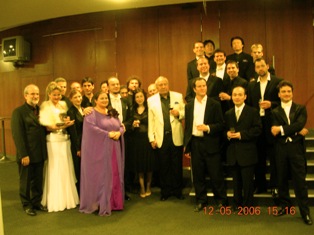
Stars of Moscow Opera and students of Neeme Järvi's Summer Academy after a concert at Pärnu Concert Hall (Järvi center in white jacket)
|
- July 15, Memorial Church of the Estonian Soldiers, Tori. Bromley
Youth Chamber Orchestra. Conductor Jonathan Josephs. Violinist Anna
Harpham. Cellist Alice Purton. The Oistrakh Festival provided free bus transportation to
this moving memorial just north of Pärnu, where the Estonian flag and a
sculpture of St. George slaying the dragon keep watch over the church and nearby
cemetery.
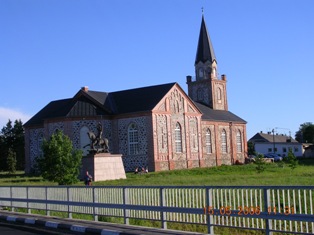
Memorial Church of the Estonian Soldiers, near Pärnu
|
The precocious youth orchestra from England performed Mozart,
Elgar, Tippet and Villa-Lobos. Violinist Anna Harpham and cellist Alice Purton
shone in Pärt’s “Fratres” and “The Protecting Veil” from John Tavener’s
work of the same name.
- July 16. Pärnu Town Hall. “The Living Classics.” “Lighten up” was
the message of this morning concert by a popular local ensemble of
mandolin, flute,trombone, accordion and piano (they sing, too).
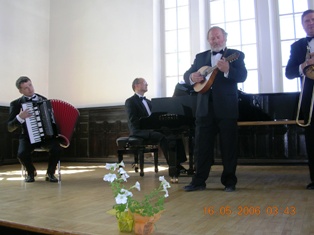
"The Living Classics" performing at Pärnu Town Hall
|
Heard were witty
arrangements of Mozart, Bach and Beethoven, a song by Estonian pop
legend Raimond Valgre (a Pärnu local) and Va pensiero from “Nabucco” which they turned
into a sing-along by passing out the lyrics to the audience. Piece de
resistance was the Andante from Haydn’s “Surprise” Symphony, where trombonist Ants
Nuut lit a firecracker under a tiny cannon and demonstrated his best
goose steps.
- July 16, Jõhvi Concert Hall. St. Petersburg Festival Chamber
Orchestra. Conductor Neeme Järvi. Oboist Kalev Kuljus. Pianist Antti
Siirala. Järvi led the crack St. Petersburg Festival Chamber Orchestra in Lutoslawski’s “Funeral
Music” and the most searing performance of any Shostakovich in my
memory, the Chamber Symphony Op.110a, an arrangement of his String Quartet No. 8
for string orchestra and timpani by Russian conductor Abram Stassevich.
Kuljus performed Mozart’s Oboe Concerto, K.314, with incredible nimbleness and
tonal beauty. One was tempted to use “perfection” to describe Siirala’s
patrician reading of Mozart’s Piano Concerto No. 27 in B-flat Major.
- July 18, Pärnu Concert Hall. Same artists as July 16, plus flutist
Sharon Bezaly and harpist Katherine Gima. Originally all Mozart,
including the oboe and piano concertos heard in Jõhvi and the Concerto for Flute and Harp with
Bezaly and Gima, the program was expanded to include the Shostakovich
Chamber Symphony. The concertos were remarkable not only for their individual
performances but as models of soloist/conductor collaboration, with
Järvi standing on the floor next to the players and exchanging signals virtually shoulder to shoulder.
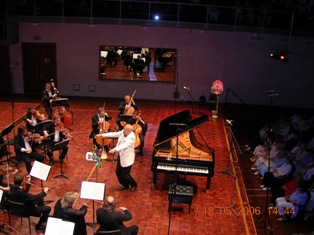
Neeme Järvi conducting encore at final concert of 2006 David Oistrakh Festival, Pärnu Concert Hall
|
Next year’s Oistrakh Festival – July, 2007, with exact dates to be
announced, will celebrate Neeme Järvi’s 70th birthday. Another special
festival is planned
for 2008, the centenary of David Oistrakh’s birth. The hope is, said
Kaasik, to contact all of Oistrakh’s living students and invite them to
Pärnu for the event.
(first published in American Record Guide, Nov.-Dec., 2006)









 Stars of Moscow Opera and students of Neeme Järvi's Summer Academy after a concert at Pärnu Concert Hall (Järvi center in white jacket)
Stars of Moscow Opera and students of Neeme Järvi's Summer Academy after a concert at Pärnu Concert Hall (Järvi center in white jacket) Memorial Church of the Estonian Soldiers, near Pärnu
Memorial Church of the Estonian Soldiers, near Pärnu "The Living Classics" performing at Pärnu Town Hall
"The Living Classics" performing at Pärnu Town Hall Neeme Järvi conducting encore at final concert of 2006 David Oistrakh Festival, Pärnu Concert Hall
Neeme Järvi conducting encore at final concert of 2006 David Oistrakh Festival, Pärnu Concert Hall